Village of Far Rockaway - 1896 dated Specimen Sewer Bond - Fantastic Graphics
Inv# GB5388 Specimen Bond$1,000 Specimen Bond. Full page of coupons attached. Rare! Far Rockaway is a neighborhood on the eastern part of the Rockaway peninsula in the New York City borough of Queens. It is the easternmost section of the Rockaways. The neighborhood extends from Beach 32nd Street east to the Nassau County line. Its southern boundary is the Atlantic Ocean; it is one of the neighborhoods along Rockaway Beach. Read more at https://en.wikipedia.org/wiki/Far_Rockaway,_Queens
Stock and Bond Specimens are made and usually retained by a printer as a record of the contract with a client, generally with manuscript contract notes such as the quantity printed. Specimens are sometimes produced for use by the printing company's sales team as examples of the firms products. These are usually marked "Specimen" and have no serial numbers.











Ebay ID: labarre_galleries